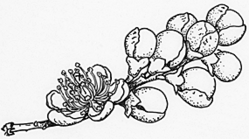
Description: Trees or shrubs.
Leaves alternate, simple, margins toothed or entire; stipules absent.
Inflorescences axillary or terminal, flowers solitary or in spikes, racemes or clustered in axils of leaves. Flowers actinomorphic, bisexual [or some unisexual and then plants polygamous], 5-merous. Calyx fused, 5-toothed. Petals 3–11, ± fused. Stamens 4–many; filaments epipetalous, free or variously fused in 1–4 series; anthers 2-locular, dehiscing by longitudinal slits. Disc absent. Ovary inferior or seldom half-inferior, 2–5-locular; style slender.
Fruit a berry or drupe, 1–5-locular, topped by persistent calyx teeth; seed 1 per loculus.
Distribution and occurrence: World: c. 250 species, eastern Asia to Fiji & Australia, North & South America. Australia: 7–10 species, Qld, N.S.W., Vic.
Text by G. J. Harden
Taxon concept:
Taxa not yet included in identification key
Symplocos candelabrum
| | Key to the species | |
| 1 | Branchlets and buds glabrous | Symplocos thwaitesii |
| Branchlets and buds hairy | 2 |
| 2 | Flowers in spikes; leaves leathery, mostly 7–15 cm long | Symplocos stawellii |
| Flowers in racemes; leaves papery, usually 3–7 cm long
Back to 1 | Symplocos baeuerlenii |
|


